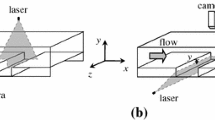Abstract
Using the standard k–ε turbulence model, a two-dimensional turbulent pipe flow was simulated with and without square cavities. Effect of cavity aspect ratio on flow and heat transfer characteristics was investigated. Uncertainty was approximated through experimental validation and grid independence. The simulation revealed circulation inside the cavities. Cavity boundaries were shown to contribute significantly toward turbulence production. Cavity presence was shown to enhance overall heat transfer through the wall, while increasing pressure drop significantly across the pipe. It was predicted that cavities with higher aspect ratio enhance heat transfer more while increasing pressure drop.








Similar content being viewed by others
Abbreviations
- A R :
-
cavity aspect ratio=C W/C D
- C W :
-
cavity width, m
- C D :
-
cavity depth, m
- C p :
-
specific heat at constant pressure, kJ/(kg K)
- C 1ε :
-
empirical constant=1.44
- C 2ε :
-
empirical constant=1.92
- C μ :
-
empirical constant=0.09
- D :
-
pipe diameter, m
- E :
-
empirical constant=9.8
- E :
-
total energy, J
- f :
-
friction factor=ΔP/(2(L/D)ρU 2in )
- h :
-
heat transfer coefficient=q/(T w-T bulk), W/(m2 K)
- k :
-
turbulence kinetic energy, m2/s2
- k :
-
fluid thermal conductivity, W/(m K)
- L :
-
pipe length, m
- Nu x :
-
local Nusselt number=hD/k
- Nu :
-
area-averaged Nusselt number
- Nu DB :
-
Nusselt number obtained by the Dittus–Boelter correlation
- p :
-
mean pressure of the fluid, Pa
- Pr t :
-
turbulent Prandtl number
- q :
-
heat flux through the wall, W/m2
- Re :
-
Reynolds number=ρU in D/μ
- T w :
-
wall temperature, K
- T in :
-
inlet temperature, K
- U :
-
mean velocity of the fluid, m/s
- Uin :
-
inlet velocity, m/s
- x i :
-
Cartesian coordinates
- δij :
-
Kronecker delta
- δ k :
-
empirical constant=1.0
- δ ε :
-
empirical constant=1.3
- Δρ :
-
pressure drop through the pipe, Pa
- ε:
-
turbulence dissipation rate, m2/s3
- κ:
-
von Karman constant=0.42
- μ:
-
dynamic viscosity of the fluid, kg/(m s)
- μ t :
-
eddy viscosity, kg/(m s)
- ρ:
-
mean density of the fluid, kg/m3
- \( \rho \overline{{U_{i} U_{j} }} \) :
-
Reynolds stresses, Pa
References
Afnas’yev VN, Chudnovskiy YaP, Leont’ev AI, Roganov PS (1993) Turbulent flow friction and heat transfer characteristics for spherical cavities on a flat plate. Exp Thermal Fluid Sci 7:1–8
Baughn JW, Hoffman MA, Takahashi RK, Launder BE (1984) Local heat transfer downstream of an abrupt expansion in a circular channel with constant wall heat flux. J Heat Transfer 106:789–796
Bearman PW, Harvey JK (1976) Golf ball aerodynamics. Aeronaut Q 27:112–122
Bearman PW, Harvey JK (1993) Control of circular cylinder flow by the use of dimples. AIAA J 31:1753–1756
Bunker RS, Donnellan KF (2002) Heat transfer and friction factors for flows inside circular tubes with concavity surfaces. GE Global Research, Technical Information Series 2002GRC351
Chyu MK, Yu Y, Ding H, Downs JP, Soechting FO (1997) Concavity enhanced heat transfer in an internal cooling passage. IGTI Turbo Expo 97-GT-437, Orlando, FL
Hinze JO (1975) Turbulence. McGraw-Hill, New York, NY, pp 403–415
Kakac S, Yener Y (1995) Convective heat transfer, 2nd edn. CRC Press, Boca Raton, FL, pp 292
Launder BE Spalding DB (1972) Lectures in mathematical models of turbulence. Academic, London, pp 90–110
Kim S, Choudhury D (1995) A near-wall treatment using wall functions sensitized to pressure gradient, ASME FED vol 217, Separated and complex flows
Mahmood GI, Hill ML, Nelson DL, Ligrani PM, Moon HK, Glezer, B (2000) Local heat transfer and flow structure on and above a dimpled surface in a channel. IGTI Turbo Expo 2000-GT-230, Munich
Nagoga GP (1996) Effective methods of cooling of blades of high temperature gas turbines. Publishing House of Moscow Aerospace Institute, Moscow
Patankar SV, Spalding DB (1972) A calculation procedure for heat, mass, and momentum transfer in three-dimensional parabolic flows. Int J Heat Mass Transfer 15:1787
Sharov D, Nakahashi K (1998) Hybrid prismatic/tetrahedral grid generation for viscous flow applications. AIAA J 36: 157–162
Stern F, Wilson R, Coleman H, Paterson E (1999) Verification and validation of cfd simulations. Iowa Institute of Hydraulic Research IIHR 407, College of Engineering, University of Iowa, Iowa City, IA: 3
Author information
Authors and Affiliations
Corresponding author
Rights and permissions
About this article
Cite this article
Alammar, K.N. Effect of cavity aspect ratio on flow and heat transfer characteristics in pipes: a numerical study. Heat Mass Transfer 42, 861–866 (2006). https://doi.org/10.1007/s00231-005-0054-x
Received:
Accepted:
Published:
Issue Date:
DOI: https://doi.org/10.1007/s00231-005-0054-x




